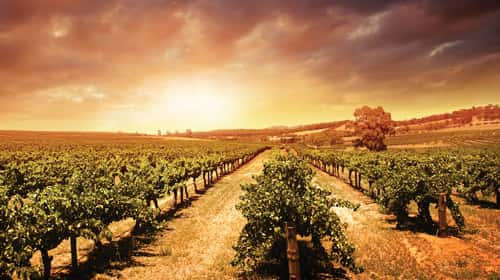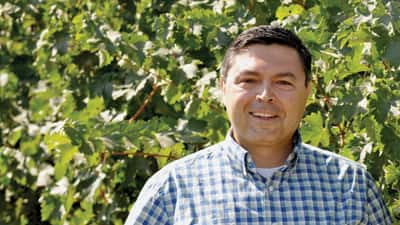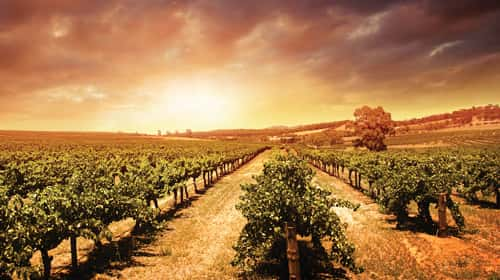 From Canada’s stony soils in frosty Nova Scotia to the chalky earth of arid Jerez, Spain, and even the fertile fields in the humid highlands of Brazil, grapes are grown and made into wine. On the one hand growing grapes is simple: Plant the prolific vines in soil, give them sunlight and water, and you’re likely to produce a cluster or two. However, to produce the finest winegrapes, requires something more.
From Canada’s stony soils in frosty Nova Scotia to the chalky earth of arid Jerez, Spain, and even the fertile fields in the humid highlands of Brazil, grapes are grown and made into wine. On the one hand growing grapes is simple: Plant the prolific vines in soil, give them sunlight and water, and you’re likely to produce a cluster or two. However, to produce the finest winegrapes, requires something more.
The world’s historic wine regions, such as France, Italy and Spain have centuries’ worth of experimentation and varietal selection to marry the type of grapes with a particular soil within their distinct climatic environments. Newer wine regions—the United States, Australia and China, for example—have often used super-charged technological approaches to speed up this process. Even so, because grapevines are woody perennials that produce fruit for decades, such an approach normally takes many years to refine.
Given that the climate is changing at what appears to be an ever-increasing rate, winegrape farmers and wine producers in all regions are racing to keep up.
A serious matter
“Climate change is very serious; however, we don’t see a future where world-class wine grapes are not being grown in our region,” says Karissa Kruse, president of the Sonoma County Grape Growers Association. “That said, the entire industry needs to work hard to keep up with the changing conditions, while finding ways to improve our farming practices. The good thing is that farmers are used to being flexible and nimble. That’s built into their DNA.”
Using a “response and responsibility” approach, Kruse explains that local farmers, agencies, businesses and academicians are all looking to understand and predict how a changing climate will impact the industry while at the same time exploring ways to help alleviate one of the greatest causes of climate change—greenhouse gases.
“We are working to define how local agriculture might respond,” says Kruse. “And although only 8 percent of greenhouse gas emissions come from agriculture-related businesses, we also need to do our part to reduce C02 and nitrous oxide emissions through improved farming practices.”
Modeling uncertainty
“Climate is what you expect and weather is what you get,” says John Abatzoglou, a climate scientist at the University of California, Merced. “Here in California, we’ve seen a wholesale shift in temperatures with about a 2 degrees Fahrenheit increase over the past half-century.”
Measured over long periods of time, climate scientists track seasonal temperature fluctuations, average rainfall and wind patterns to model the future.
“As the climate changes, models predict that what used to be a rare hot day will occur much more frequently,” says James McMahon, co-founder and chief executive officer at The Climate Service. “Our analysis…shows that high temperatures in Northern California will rise sharply in years to come. For example, the average number of days above 86 degrees will rise from about 13 per year during the 1980s to 65 days per year over the next 20 or so years. Changes in extreme temperatures have the potential to impact all industries but most especially agriculture.”
A changing climate may make it difficult to maintain and grow crops because of unpredictable weather, which can result in extreme conditions—floods, droughts, higher winds and increased fire risk. “Many crops, including grapes, need very specific conditions in order to thrive,” says McMahon. “Dramatic and unpredictable changes to those conditions make it very difficult for farmers, the agriculture industry and the end buyers to predict yields. In this way, the unpredictability of weather conditions leads inextricably to unpredictability in business.”
Tipping point
“We’re at the tipping point,” says Sahap Kaan Kurtural, cooperative extension specialist in viticulture with the University of California, Davis, department of viticulture and enology. Kurtural is headquartered at the department’s Oakville Station, a 40-acre research vineyard in the Napa Valley. The station’s work is focused on understanding the impacts of climate change on winegrapes.
High temperatures are a concern because ambient temperatures above approximately 90 degrees cause a grapevine’s entire metabolic process to shut down and grapes to dehydrate. Extreme heat can also alter the timing and quality of color and flavor maturation and, at the same time, reduce yields.
 “There are vineyards in Southern California right now being replaced by crops like almonds and pistachios,” says Kurtural. “Those crops become more valuable as the value of the grape varietal they replaced is decreasing. Much of those effects have been due to increased temperatures—hotter days, but also warmer nights, which can have a negative impact on normal vine physiology and lead to a detrimental effect on quality.”
“There are vineyards in Southern California right now being replaced by crops like almonds and pistachios,” says Kurtural. “Those crops become more valuable as the value of the grape varietal they replaced is decreasing. Much of those effects have been due to increased temperatures—hotter days, but also warmer nights, which can have a negative impact on normal vine physiology and lead to a detrimental effect on quality.”
Beyond the impacts of high heat, grape farmers also closely watch the amount of time a grapevine is exposed to cold temperatures during winter dormancy. A period of a certain amount of cold weather is required for a normal grapevine’s growth cycle and is necessary for bud break and spring growth. Even small changes can have big impacts. “A 2 degree Fahrenheit warming would lead to an earlier ripening of winegrapes (by a couple weeks), which may impact overall quality,” says Abatzoglou. “This is particularly troublesome and carries risks for agriculture.”
Cold weather hinders pests and disease
Some vineyard diseases, Pierce’s disease and leafroll, for example, are transmitted by insects. The fear of many farmers is that changing winter conditions might allow new pests to migrate in and potentially transport new pathogens that might find a new hospitable environment within the warmer vineyards. This fear is not limited to grapevines. The extremely warm winter of 2013 helped fuel a bark-beetle infestations that has plagued the Southern California Sierras, killing millions of trees weakened by years of drought that would otherwise have been protected. The insect is normally kept in check by temperatures below freezing, according to Garrett Buckland, winemaker and partner at Premiere Viticultural Services in Napa. “I don’t see a time when we won’t grow premier Cabernet Sauvignon in the Napa Valley, but we will need to continually ‘future-proof’ our viticultural practices as the environmental conditions change,” says Buckland.
Future proof
 According to Buckland, part of future-proofing includes using and/or developing new practices that deal with extreme shifts in temperature, but it also explores how agriculture might respond to other effects fueled by climate change. For example, even minor increases in levels of humidity can provide optimal conditions for various molds, mildews and fungi that are not normally a problem in Northern California grape farming. But even less-novel events may have their own repercussions. Late fall rains can make working in the fields with tractors challenging and may lead to earth compaction, which can have a negative impact on permeability. Heavy winds during flowering can also reduce yields.
According to Buckland, part of future-proofing includes using and/or developing new practices that deal with extreme shifts in temperature, but it also explores how agriculture might respond to other effects fueled by climate change. For example, even minor increases in levels of humidity can provide optimal conditions for various molds, mildews and fungi that are not normally a problem in Northern California grape farming. But even less-novel events may have their own repercussions. Late fall rains can make working in the fields with tractors challenging and may lead to earth compaction, which can have a negative impact on permeability. Heavy winds during flowering can also reduce yields.
“We need to mitigate against the risks associated with higher temperatures, changing rainfall patterns, and the threat of more fires and increasing disease pressure,” says Buckland. “We must also continue to develop and improve our climate-positive farming practices. At the same time, we must continue to foster a more sustainable mindset throughout the industry.”
Beyond the hazards of too much water, drought is an ever-present threat in California, and the threat seems to be increasing. Only broken by the wettest period in the state’s history (2016 through 2017), 12 of the last 14 years have been classified as drought years. The result is that some vineyards in locations with low rainfall and high-salt-concentrated soils have been abandoned in parts of the state, such as a few on the east side of Highway 101 in Paso Robles.
Implementing change
“In Sonoma County, we have a sort of built-in flexibility because of the dozens of different micro climates and soil types that our farmers have been experimenting with for years,” says Kruse. “Our approach with launching the Climate Adaptation Certification with our local growers is to better understand the impact of different farming practices with these diverse microclimates and soils to have optimal climate-friendly farming. This data and modeling can then be shared broadly so that all agriculture can benefit.”
Beyond the challenge of understanding the nature of climate change is the fact that although farming practices might need to change, at present it is unclear exactly how a typical farmer might employ such changes, especially if the outcome is uncertain and the implication costly.
“Farmers are a practical bunch, and if you can’t show them a clear benefit that makes economic sense then that’s probably not going to get you very far,” says Laurel Marcus, executive director of Fish Friendly Farming, which is run by the California Land Stewardship Institute. “We’ve just launched a trial program with Sonoma County farmers to lay the groundwork for what we hope in the future will be a climate adaption certification,” she adds. “The goal is to figure out the best practices when it comes to reducing a farmer’s carbon footprint and how they can sequester carbon on their farm, but also determine how best to deal with changing conditions going forward. Ultimately, we need to work together to figure this out. The solutions need to have impact, but they also need to be realistic and make economic sense for our farmers. It’s no good coming up with a plan that either no one uses or that puts a farmer out of business.”
Exploring ways to respond
“Here at the Oakville Station, we are exploring the benefits of using shade cloth to help reduce sun damage and extreme temperatures,” says Kurtural. “We have also developed molecular markers to test for water stress and another one to test for solar radiation damage. Beyond looking at these tools, our team is testing everything from different trellis systems, pruning alternatives, improved irrigation practices, rootstock-cultivar combinations and cover-crop management to collect data that may help our understanding of the current situation, but also to provide the industry tools they need to manage the current and future environments.”
Unlike many agriculture crops that can be mass-farmed, in at least semi-uniform landscapes, vineyards such as those in Northern California are often owned and operated on a smaller scale and geared toward producing a luxury product—wine. Therefore, there are plenty of individual vineyard owners who are attempting to study the effects of climate change on their own.
“I have over 20 vineyard clients, and each of them is doing something in an attempt to mitigate changing climate conditions,” says Buckland. “We’re doing things now that would have been unimaginable even 10 years ago, and the great thing is that grape farmers are happy to share their findings with their neighbors.”
Vineyard approaches
According to Buckland and the other experts, the keys to helping protect against extreme weather events involve a number of farming strategies.
Some are also experimenting with reflective clay sprays to keep berries from overheating during the hottest days. And though Kurtural suggested that there is no evidence that water-misting is effective, there are plenty of farmers deploying this technique, too.
Of course, it’s always possible to replace an existing cooler-weather-loving varietal of wine grape such as Pinot Noir and Chardonnay with warmer-preferring varietals such as Merlot, or even with hot-environment-loving varietals such as Cabernet Sauvignon and Grenache. “We have already seen Pinot Noir and Chardonnay in Carneros being replaced by Merlot,” says Paul Anamosa, owner of Vineyard Soil Technologies, a Napa-based company that provides services for vineyard development and management.
Carbon neutral farming
“The local industry and UC Davis are at the cutting edge,” says Buckland. “What we find might eventually be implemented in other industries. For example, keeping permanent cover crops and employing some organic techniques might increase the organic matter in the soil a few percentage points. It might not sound like a lot, but if the entire agriculture community adopted just some of our practices, it would make a big impact.”
To improve carbon sequestration within the vineyards, operators are exploring non-till cover crops, finding ways to reduce fossil-fuel-powered tractors, using alternative power sources such as solar and hydrogen, using organic practices and finding ways to recycle old vines besides burning them in the field.
“Beyond using biodynamic and organic techniques for farming, we intend to make our vineyard operations carbon-neutral, using our proven solar-based electrical system to power the entire operation,” says Mac McQuown, owner of Sonoma’s Silver Cloud vineyard and Stone Edge Farm. “We are on a mission to reduce our carbon footprint to zero while at the same time ensuring reliability and maintaining the highest quality.”
McQuown and his team have achieved part of their goal already. Their Stone Edge Farm can generate all of its own power, so it was able to maintain itself, even through the recent PG&E power shutoffs of 2017 and 2019.
 “They’ve shown that it can be done at their farm, and now we want to show we can do the same thing on a mountaintop vineyard,” says Phil Coturri, CEO of Enterprise Vineyards, a Sonoma-based viticultural management company that has worked with McQuown for the last 20 years. “Everyone I farm with is putting up solar arrays,” he says. “But Mac and his team are going one step further and planning to use the hydrogen they make using solar energy so they might fuel everything from wind machines to hopefully even tractors someday. It’s really revolutionary.”
“They’ve shown that it can be done at their farm, and now we want to show we can do the same thing on a mountaintop vineyard,” says Phil Coturri, CEO of Enterprise Vineyards, a Sonoma-based viticultural management company that has worked with McQuown for the last 20 years. “Everyone I farm with is putting up solar arrays,” he says. “But Mac and his team are going one step further and planning to use the hydrogen they make using solar energy so they might fuel everything from wind machines to hopefully even tractors someday. It’s really revolutionary.”
Coturri is considering using shade cloth on some of his vineyards, but he’s exploring alternatives to the standard plastic options because of environmental concerns. “We have enough plastic in this world already, so I’m looking at canvas and even hemp-based alternatives,” he says. “A few years ago I wouldn’t have even considered it, but it’s increasingly becoming necessary.”
The future of Wine Country
Will the future of the Northern California wine industry look different from the way it does today? Most certainly. Warmer-condition varietals such as Cabernet Sauvignon, Sauvignon Blanc, Zinfandel and Carignane may eventually replace many of the cooler-area vineyards currently planted in Chardonnay and Pinot Noir. There is also going to be a lot more shade cloth draped over and around vines, fewer tilled-earth vineyards and more new vine rows that take their orientation cues more from the sun than the area’s highways.
Beyond the many tips on how to deal with changing climatic conditions, each expert was also clear that there is little certainty when it comes to how (or how much) temperatures and weather will change in the coming years.
Predictions of how severely the local climate will change run the gamut from a gradual shift in temperatures to a cataclysmic Armageddon that will render the region’s grape industry non-existent within 50 years. The truth is that no one knows for certain. However, one thing is clear: those who grow and make wine are at the leading edge of our understanding of the real impacts of climate change. The industry has the opportunity to take a leadership role when it comes to developing potential solutions to deal with the immediate effects while at the same time implementing farming practices that help to alleviate, or at least not exacerbate, the situation.
“The profit margins of wine encourage us, actually require us, to farm responsibly,” says Coturri “We all have the opportunity to make a positive impact.”




